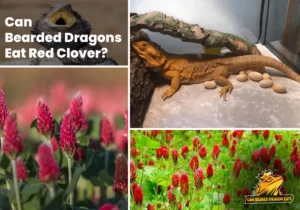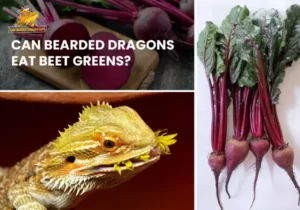Bearded dragons are charismatic reptiles that captivate with their distinctive features and behaviors. A crucial aspect of their care involves their diet, particularly whether they can consume greens. Indeed, greens are an essential component of a bearded dragon’s diet, providing necessary nutrients that are vital for their health.
Leafy greens such as collard, mustard, and turnip greens should be regular staples. These greens offer a rich supply of vitamins A, C, and K and crucial minerals like calcium, which are indispensable for preventing metabolic bone disease. However, balance is key. In an adult bearded dragon’s diet, greens should represent about 20-25% of their food intake, with the rest comprising a mix of other vegetables, fruits, and insects.
For juvenile dragons, the emphasis is on protein to support their growth, but greens still play a significant role. Owners should aim for a dietary calcium-to-phosphorus ratio of around 2:1 to ensure optimal health.
Incorporating greens into your bearded dragon’s diet isn’t just a matter of nutrition; it’s a step towards mimicking their natural habitat, contributing to their overall well-being. Choose greens wisely, and your bearded dragon will enjoy a robust and healthful life.
The Importance of Calcium-rich Greens for Bearded Dragons
Four compelling reasons why greens are important to a bearded dragon’s health, which could serve as subsections under an H2 title:
Nutrient-Rich Diet Staples
Greens are packed with essential vitamins and minerals that are crucial for a bearded dragon’s overall health. They are rich sources of vitamin A for good vision, vitamin C for immune function, and vitamin K for blood clotting.
Promoting Digestive Health
The high fiber content in greens aids in the digestive process, helping to prevent constipation and maintain a healthy gut flora, which is essential for bearded dragons.
Calcium for Bone Structure
Greens like collard and mustard greens are high in calcium, which is necessary for the development and maintenance of strong bones, helping to prevent metabolic bone disease, a common ailment in captive bearded dragons.
Hydration and Fullness
Greens contain a significant amount of water, which helps keep bearded dragons hydrated. Additionally, the bulk of leafy greens can help these reptiles feel full without the risk of obesity from higher-calorie foods.
Benefits of Greene in a Bearded Dragon's Diet
Optimal Growth and Development
Greens are vital for the growth and development of bearded dragons, providing necessary vitamins and minerals that contribute to their overall health and vitality.
Prevention of Nutritional Deficiencies
Regular consumption of a variety of greens helps prevent nutritional deficiencies, particularly of vitamins A and C, which are crucial for maintaining good vision, skin health, and immune system function.
Bone Health and Density
Greens are an excellent source of calcium, an essential mineral for bone health. This is especially important for bearded dragons to prevent metabolic bone disease, which can be life-threatening if not addressed through proper nutrition.
Digestive Regularity
The fiber in greens aids in digestion, promoting regular bowel movements and preventing constipation, which is a common health issue in bearded dragons.
Weight Management: Greens have low caloric content yet are filling, which helps manage weight and prevent obesity—a common problem in captive bearded dragons due to overfeeding and lack of exercise.
Hydration
Greens have high water content, providing an additional hydration source, which is beneficial for bearded dragons as they often do not drink enough water on their own.
Behavioral Enrichment
Foraging on greens can mimic a bearded dragon’s natural feeding behaviors, providing mental stimulation and helping to prevent boredom in captivity.
Greene that can be offered to bearded dragons
Collard Greens
Nutritional Content: High in calcium, vitamins A, C, and K, as well as folate and fiber.
Feeding Recommendations: Can be fed daily; make up the bulk of the greens offered.
Turnip Greens
Nutritional Content: Rich in calcium, vitamin A, C, and folate, with a good calcium to phosphorus ratio.
Feeding Recommendations: Can be fed daily; should be a staple green in the diet.
Mustard Greens
Nutritional Content: Contain calcium, fiber, vitamins A, C, E, and K.
Feeding Recommendations: Can be offered daily; provide in moderation due to slightly higher oxalate levels.
Dandelion Greens
Nutritional Content: High in calcium, vitamins A, C, and K, and also provide some iron.
Feeding Recommendations: Can be given daily; highly nutritious and generally well-accepted.
Kale
Nutritional Content: Provides vitamins A, C, K, iron, and antioxidants, but is higher in oxalates.
Feeding Recommendations: Feed 2-3 times a week; use sparingly due to oxalates.
Parsley
Nutritional Content: Good source of vitamin K, A, and C, but also contains oxalates.
Feeding Recommendations: Offer occasionally; no more than once a week.
Spinach
Nutritional Content: High in vitamins A, C, K, iron, and folate, but very high in oxalates.
Feeding Recommendations: Rarely, if ever, offered; potentially once a month in very small quantities.
Swiss Chard
Nutritional Content: Contains vitamins A and K, calcium, and iron but is high in oxalates.
Feeding Recommendations: Feed sparingly, no more than once a week.
Arugula
Nutritional Content: High in vitamins A and C, calcium, and is a good source of folate.
Feeding Recommendations: Can be offered a couple of times a week as part of a greens mix.
Watercress
Nutritional Content: Abundant in vitamins A, C, and K, calcium, and antioxidants.
Feeding Recommendations: This can be fed daily, but it is best to rotate with other greens for variety.
How You Can Prepare Greene for Feeding?
Preparing greens for your bearded dragon is a simple process that is vital for ensuring they receive maximum nutritional benefits from their meals. Here’s how you can prepare greens for feeding:
Selection of Greens
Choose fresh, high-quality greens. Organic options are ideal as they are less likely to contain pesticides.
Washing
Rinse the greens thoroughly under cool running water to remove any dirt, chemicals, or potential insects.
Chopping
Cut the greens into bite-sized pieces. The size should be appropriate for your bearded dragon to easily consume—no larger than the space between their eyes to prevent choking.
Mixing
Prepare a salad mix by combining different types of recommended greens to provide a variety of nutrients. This also keeps mealtime interesting for your pet.
Drying
After washing and before chopping, you can gently pat the greens dry with a paper towel to remove excess water, preventing the habitat from becoming too damp.
Supplementation
If recommended by your vet, dust the greens with a calcium or vitamin supplement to ensure your bearded dragon gets its required dietary supplements. This is usually done right before feeding to prevent the powder from being absorbed by the moisture in the greens.
Serving
Place the greens in a shallow dish that your bearded dragon can easily access. The dish should be heavy enough to prevent tipping over.
Frequency and Portion Size
Offer greens as part of the daily diet for adults and multiple times a day for juveniles, as they require more frequent feedings. The portion size should be in line with your bearded dragon’s size and nutritional needs.
Removing Uneaten Greens
After feeding time, typically 30 minutes to an hour, remove any uneaten greens to prevent them from spoiling and attracting pests.
Observation
Monitor your bearded dragon’s eating habits. Some may prefer certain greens over others, and it’s important to notice what they like and any changes in their eating behavior.
How Too Much Greene Can Harm Your Bearded Dragon's Health?
Feeding too much of certain types of greens can indeed harm your bearded dragon’s health. While greens are an essential part of their diet, it is crucial to offer a balanced variety. Here are some ways in which an imbalance caused by too much of certain greens can lead to health issues:
Oxalate Content
Greens like spinach and beet tops are high in oxalates, which bind to calcium and other crucial minerals, preventing their absorption. Over time, a diet high in these greens can lead to calcium deficiencies, resulting in metabolic bone disease.
Goitrogens
Some greens, such as kale and cabbage, contain goitrogens, which can interfere with thyroid function if fed in large quantities over time. This can lead to goiter and other metabolic issues.
Digestive Problems
Greens high in fiber are good for digestion in moderate amounts, but too much fiber can lead to digestive issues, including diarrhea, which can result in dehydration and nutrient loss.
Nutrient Imbalance
Focusing too much on certain greens can lead to an imbalance in vitamins and minerals. For instance, too much vitamin A (found in carrots and sweet potatoes) can lead to vitamin A toxicity, while not enough can cause deficiencies.
Picky Eating
Overfeeding a particular type of green can lead to picky eating habits, where the bearded dragon may refuse to eat other necessary foods, leading to an imbalanced diet.
Hydration Issues
Although greens contain water and can aid in hydration, too much moisture from greens can also cause diarrhea, which in turn can lead to dehydration if not balanced with proper water intake
Greene That Should Be Avoid In Bearded Dragons Diet
Certain greens and plants should be avoided in a bearded dragon’s diet due to their potential harmful effects. Here are some greens and other plants that are generally recommended to be excluded:
Rhubarb: Contains oxalic acid, which is toxic to bearded dragons and can lead to kidney failure.
Avocado: The leaves and fruit contain persin, which is toxic to many animals, including bearded dragons.
Onions and Garlic: These can cause blood abnormalities and digestive issues.
Spinach: While not toxic, spinach contains high levels of oxalates, which can bind to calcium and inhibit its absorption, potentially leading to metabolic bone disease if fed regularly.
Lettuce: Particularly iceberg lettuce, which is very low in nutrients and high in water content, providing little nutritional value and potentially causing diarrhea.
Wild plants: Unless you are certain that a wild plant is safe and not treated with pesticides or herbicides, it’s best to avoid feeding it to your bearded dragon.
Tomato leaves and stems: The leaves and stems of tomato plants are toxic, although the fruit is safe in moderation.
Citrus fruits: While not a green, citrus fruits like oranges and lemons are often mistakenly considered potential vitamin C sources. They are too acidic for bearded dragons and can upset their stomach.
Beet Tops: The leaves of beets are high in oxalates, similar to spinach.
Beans: Raw beans can be harmful due to substances that can interfere with vitamin absorption and digestion.
Mushrooms: Not a plant but often grouped with vegetables, mushrooms can be difficult to digest, and some varieties can be toxic.
The Bottom Line
A well-balanced diet rich in appropriate greens is crucial for the health and longevity of bearded dragons. While greens such as collard, mustard, and turnip greens, along with dandelion and arugula, provide essential nutrients like vitamins A, C, and K, and minerals like calcium, they must be offered in moderation to prevent nutritional imbalances. Certain greens high in oxalates or goitrogens, such as spinach and kale, should be fed sparingly, while others, like rhubarb, avocado, and iceberg lettuce, should be avoided altogether due to their potential toxic effects or lack of nutritional value.
Can Bearded Dragons Eat Iceberg Lettuce? Unveiling the Facts
When it comes to the dietary habits of bearded dragons,...
Read MoreCan Bearded Dragons Eat Red Clover?
Bearded dragons, with their unique dietary needs, require a well-balanced...
Read MoreCan Bearded Dragons Eat Baby Bok Choy?
Bearded dragons are fascinating reptilian pets that require a balanced...
Read MoreCan Bearded Dragons Eat Swiss Chard?
I’m constantly on the lookout for the best nutrition options...
Read MoreCan Bearded Dragons Eat Chard?
Embarking on a quest to uncover unconventional delicacies for my...
Read MoreCan Bearded Dragons Eat Mustard Greens? (Full Guide)
Can Bearded Dragons Eat Mustard Greens? Absolutely Yes! As a...
Read MoreCan Bearded Dragons Eat Turnip Greens?
Can bearded dragons eat turnip greens? The answer is YES!...
Read MoreCan Bearded Dragons Eat Collard Greens?
Are you considering adding a bearded dragon to your family...
Read MoreCan Bearded Dragons Eat Dandelion Greens?
If you are wondering, “Can bearded dragons eat dandelion greens?”...
Read MoreCan Bearded Dragons Eat Radish Greens?
When it comes to feeding my beloved beardie, I once...
Read More









